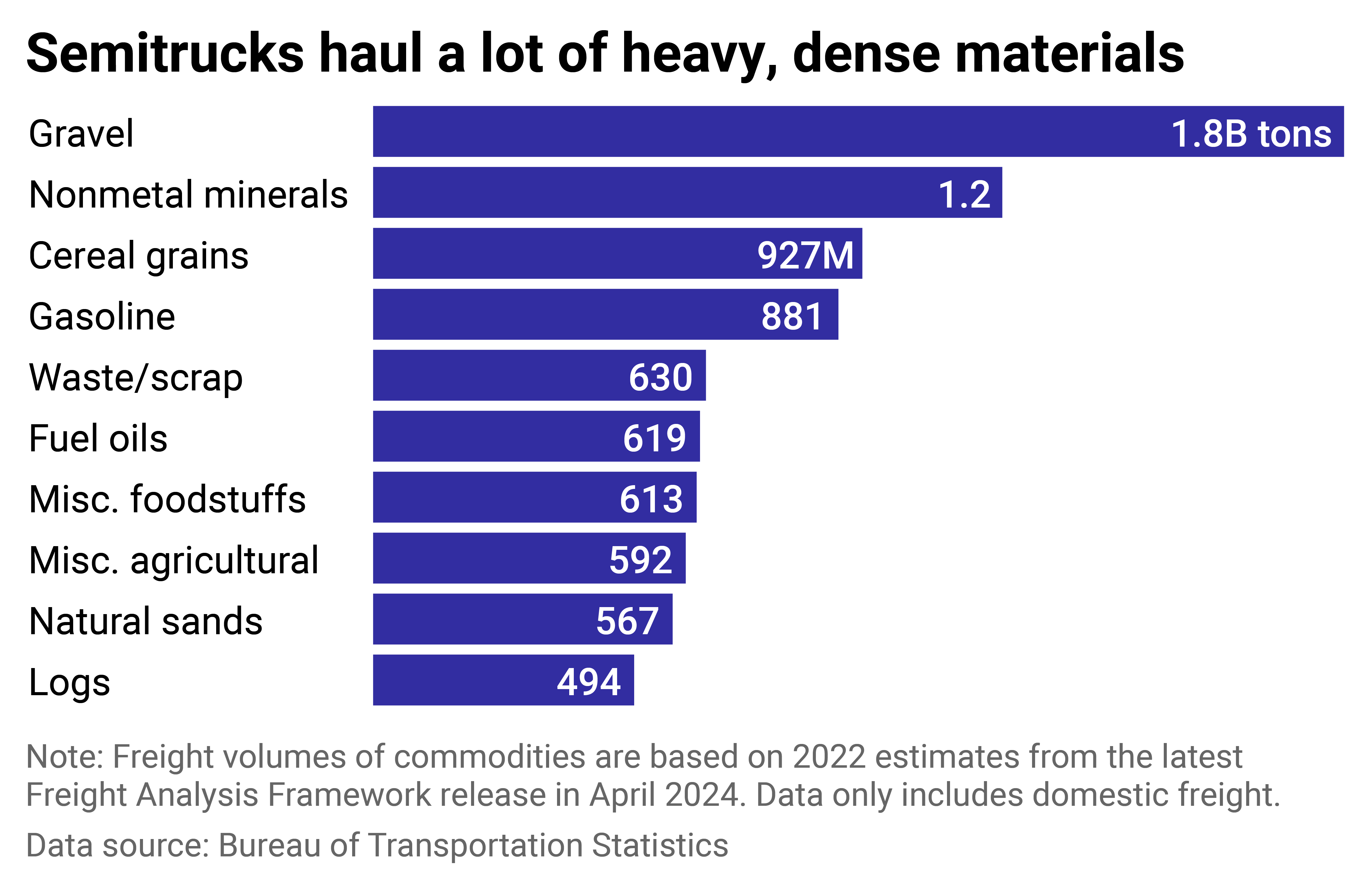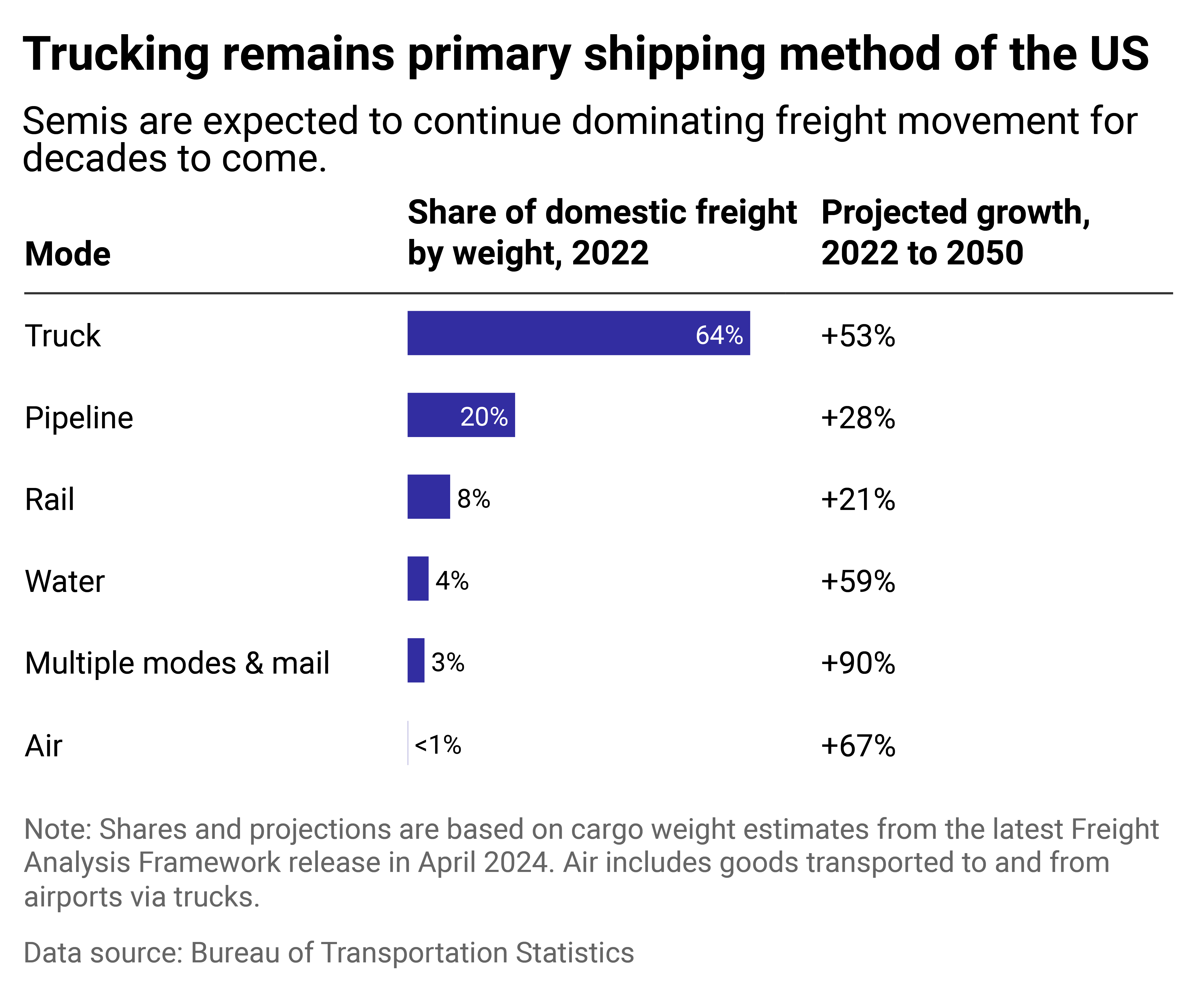Ever wonder what's inside big rigs? These are the most common goods shipped by trucks

DuxX // Shutterstock
Ever wonder what’s inside big rigs? These are the most common goods shipped by trucks
Two truck drivers review clipboard in front of semi truck.
Drivers may take notice when behind a logging truck on the interstate, a semi towing a livestock trailer, or a loudly branded Amazon shipping container, but what about the many more semitrucks crisscrossing the U.S. without offering a clue to what lies within? These anonymous giants ply the nation’s highways from sunrise until long after sunset.
Nearly two-thirds of the nation’s 20 billion tons of domestic freight is transported by truck, making semis the most prevalent method of sending goods across the U.S. So what are they most often hauling?
Truck Parking Club used data from the Bureau of Transportation Statistics to identify the most common goods transported by semitrucks within the U.S. based on weight. This analysis also charts the expected growth of shipping freight, with semitrucks continuing to lead the way.
![]()

Truck Parking Club
Earthy materials, foodstuffs fill most semitrucks
A bar chart showing the top 10 products shipped via semi truck in the U.S., measured by weight. They include gravel, nonmetal minerals, cereal grains, gasoline, waste and scrap, fuel oils, miscellaneous foodstuffs, miscellaneous agricultural, natural sands, and logs.
In some cases, the mystery of what’s inside may be more thrilling than what the trucks are actually hauling. By weight, the item most frequently transported by truck is gravel, followed by nonmetal minerals, which include materials like clay or cement. These products are, of course, very heavy and dense, contributing to their high rankings among transported materials by tons.
Even so, these substances, important components in the booming construction industry, are in high demand throughout the country. Nationally, construction spending has already reached $2.1 trillion as of May 2024, the highest level in the past 30 years, according to Census Bureau data. Gravel, minerals, sands, and logs are shipped around the country to be used in foundations, buildings, roads, and more, helping them achieve their top-10 slots.
Other common goods are part of the food supply chain. Among them are cereal grains, including wheat, corn, rice, and oats—staples in most diets. Another is miscellaneous foodstuffs, a wide range of foods like dairy products, frozen or processed foods, spices, cooking oils, and more. These foods are largely shelf-stable or long-lasting and can be shipped and stored in greater quantities.
Gasoline, the substance that keeps Americans moving, is another top commodity shipped across the country. And, as people create record levels of garbage, waste has become another major category as semitrucks transport trash to landfills and recycling centers.

Truck Parking Club
Nearly two-thirds of US freight shipped via trucks
A table showing the share of domestic freight hauled by truck, train, plane, pipeline, multiple modes, and mail, as well as the projected change in freight hauled using that method by 2050. Trucks currently haul the vast majority of freight by weight, and will likely continue to in the future.
The vast majority of U.S. domestic freight is transported via truck, and that lead is only expected to grow. The bureau projects that large trucks will haul over 19 billion tons of goods annually by 2050—nearly as much as all shipping modes haul today.
Pipelines are the next-highest route for U.S. domestic goods—largely flowing with crude petroleum and natural gas. Rail, water, air, and multiple-mode and mail shipping each moved less than 10% of freight by weight in 2022. Trucks carry all kinds of goods, while rail and water modes most often carry bulk products, and air shipping is reserved for smaller quantities of high-value items, such as electronics and medicines.
Semitrucks have the most available infrastructure of all shipping methods in the U.S., and near-total road access means they can deliver items almost anywhere in the country. Meanwhile, planes, trains, and barges are limited by ports and tracks, which aren’t as ubiquitous in the nation’s infrastructure.
Still, each of these shipping modes will likely grow in the decades to come as Americans, corporations, and governments continue building out infrastructure and consuming goods. BTS projects that multiple-mode and mail deliveries will grow fastest, nearly doubling in the decades to come. This category includes goods shipped through mail and parcel delivery, the paths of which are often a mystery to senders, as well as freight that moved through multiple vehicle types, such as by truck and rail.
The U.S. is in the midst of a major infrastructure revamp, thanks partly to the Bipartisan Infrastructure Law, which President Joe Biden signed in November 2021. The law is investing hundreds of millions of dollars into repairing, expanding, and modernizing roads, bridges, ports, pipes, and more. Analysts predict this will improve the efficiency, reliability, and cost-effectiveness of transporting people and goods, boosting the economy.
Story editing by Carren Jao. Additional editing by Kelly Glass. Copy editing by Kristen Wegrzyn.
This story originally appeared on Truck Parking Club and was produced and
distributed in partnership with Stacker Studio.